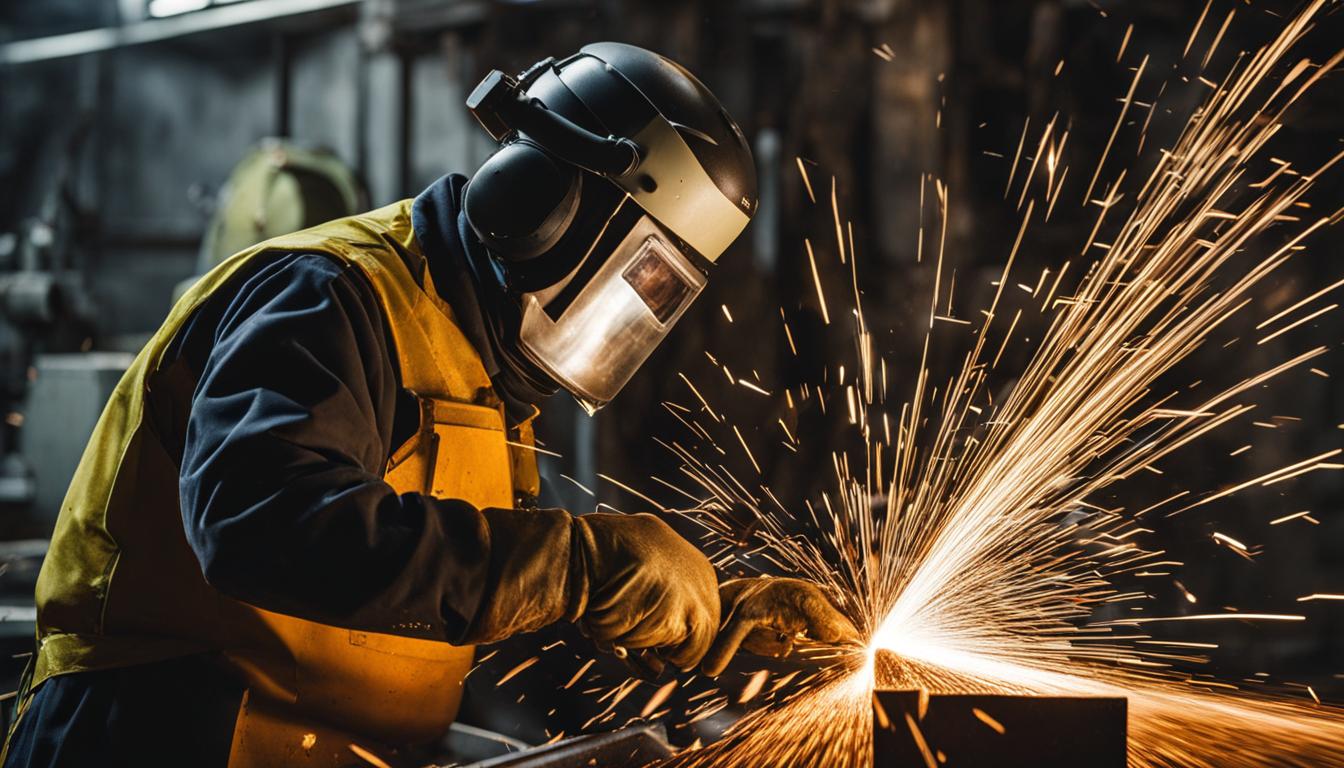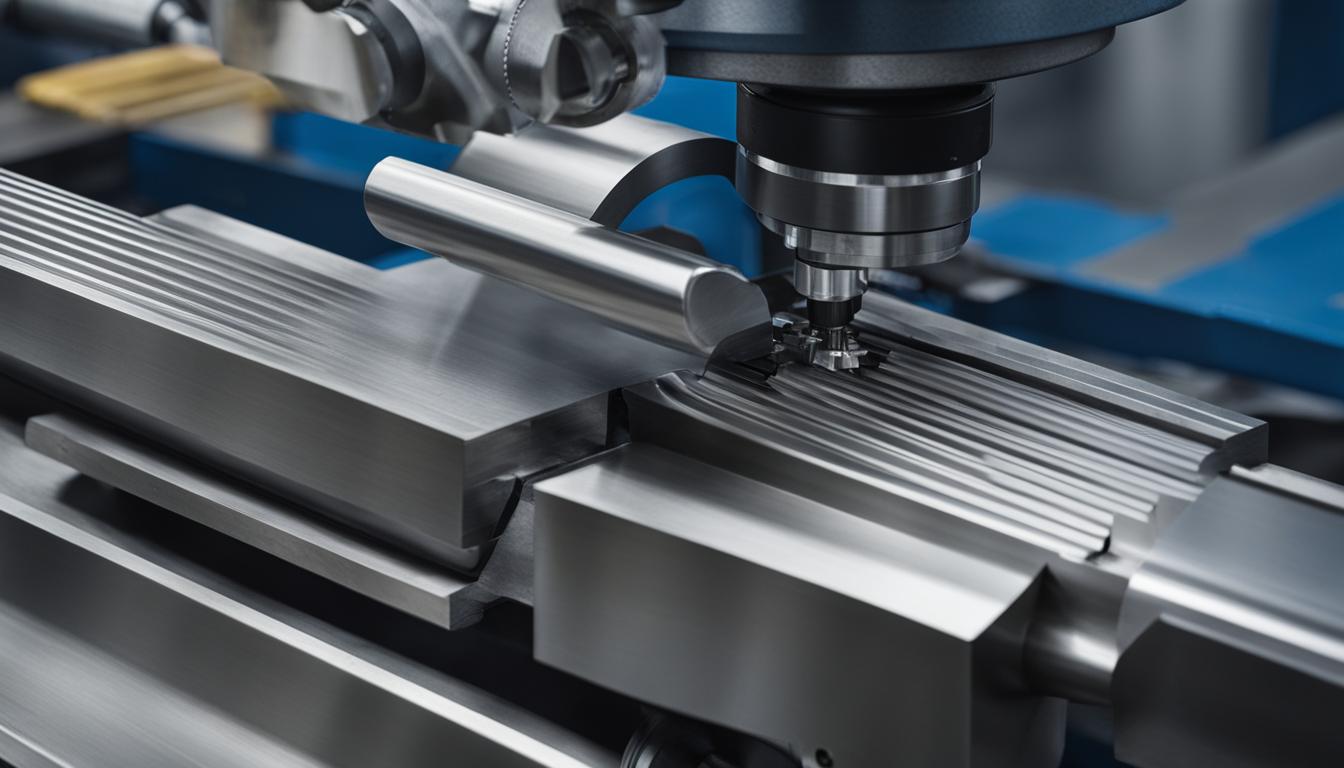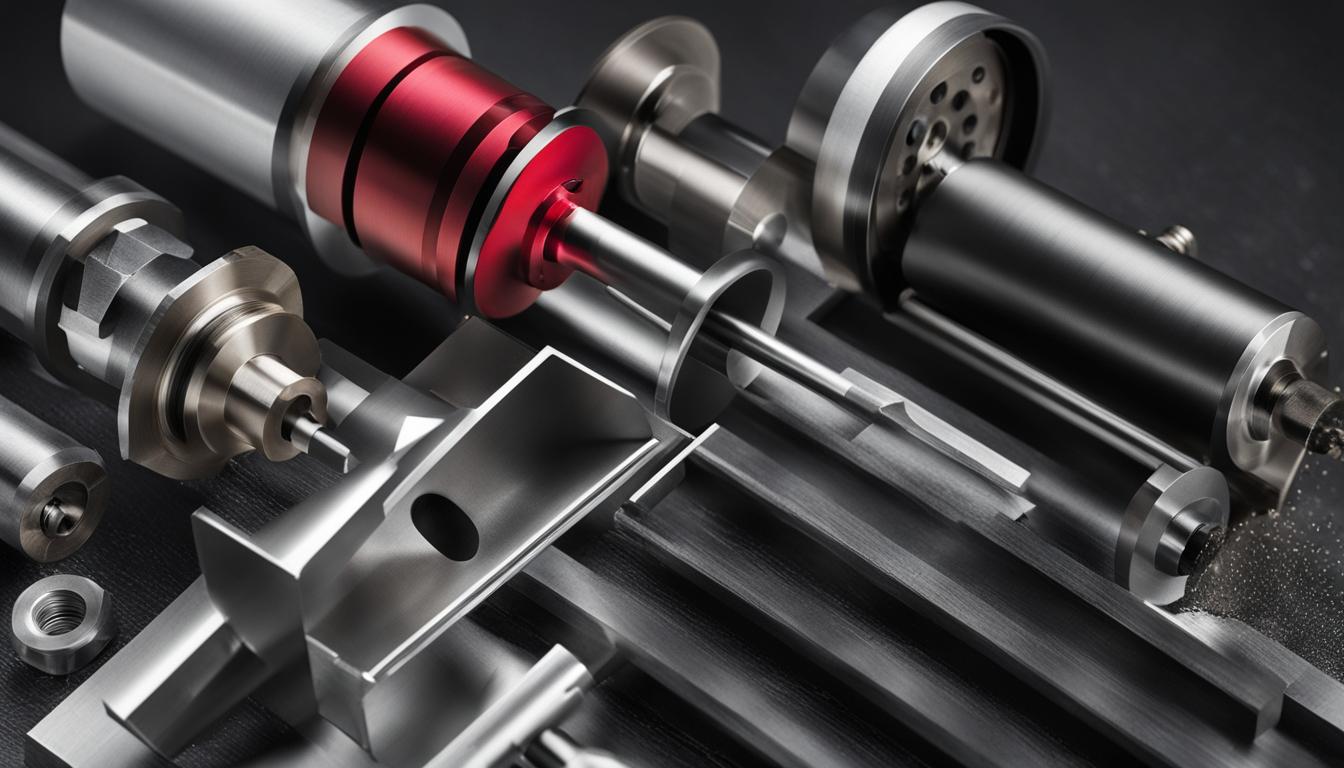Milling is a widely used manufacturing process that involves removing material from a workpiece using rotating cutting tools. It is a versatile technique that can be used to produce a variety of shapes and finishes. In this article, we will explore the different types of milling processes and their applications.
There are several types of milling operations, each designed for specific purposes. These include face milling, slot milling, end milling, thread milling, shoulder milling, side milling, profile milling, saw milling, CAM milling, and gear milling. Each of these processes has its own unique characteristics and benefits.
Key Takeaways
- There are multiple types of milling processes, each suited for specific applications.
- Milling processes include face milling, slot milling, end milling, thread milling, shoulder milling, side milling, profile milling, saw milling, CAM milling, and gear milling.
- Each milling process has its own unique characteristics and benefits.
- Milling is a versatile technique that can be used to produce various shapes and finishes.
- Understanding the different types of milling processes can help optimize manufacturing operations and improve product quality.
Face Milling
Face milling is a widely used milling process in manufacturing industries. It involves the use of a flat end face cutting tool to remove material from the surface of a workpiece, resulting in flat surfaces with precise finishes. This technique is particularly effective for producing large workpieces with smooth and flat surfaces.
One of the key advantages of face milling is its ability to achieve exceptional surface flatness. The flat end face cutting tool removes material evenly, ensuring that the resulting surface is level and free from imperfections. This makes it an ideal choice for applications that require precise finishes and flatness, such as the manufacturing of engine blocks and metal plates.
Furthermore, face milling is suitable for machining a wide range of materials, including metals, plastics, and composites. The process can be adjusted to accommodate different material properties and cutting requirements, making it versatile for various applications in the manufacturing industry.
In addition to its versatility and precision, face milling also offers advantages in terms of efficiency and productivity. By removing material in a single pass, face milling allows for faster machining times compared to other milling techniques. This makes it a cost-effective solution for large-scale production and machining operations.
Overall, face milling is an essential milling process that plays a critical role in manufacturing industries. Its ability to produce flat surfaces with precise finishes on large workpieces makes it indispensable for a wide range of applications.
Advantages of Face Milling:
- Produces flat surfaces
- Enables precise finishes
- Suitable for manufacturing large workpieces
- Versatile for different materials
- Efficient and cost-effective
Face Milling Applications
| Application | Material | Surface Finish |
|---|---|---|
| Engine blocks | Aluminum | Smooth, flat |
| Metal plates | Steel | Precise, uniform |
| Composite panels | Fiberglass | Even, polished |
Slot Milling
Slot milling is a milling technique commonly used to create slots or channels in a workpiece. It involves the use of a specialized cutting tool, such as an end mill or slotting cutter, to remove material and form slots of various shapes and sizes.
Slot milling is widely employed in various industries, including manufacturing and construction, to produce keyways, grooves, and other slot features in a workpiece. These slots and channels serve important functions, such as guiding components, accommodating fasteners, or providing pathways for fluids or electrical wiring.
The specialized cutting tools used in slot milling are designed with flutes or teeth that effectively remove material, allowing for precise slot formation. The cutting edges of these tools are engineered to create slots with different profiles, enabling the production of slots with straight, curved, or irregular shapes.
Keyways and grooves are common applications of slot milling. Keyways are narrow slots used to fit keys in rotating machine parts, providing a secure connection between the shaft and the component. Grooves, on the other hand, are wider slots often found in components like pulleys or gears, providing space for belts or other mechanical elements.
Here is an example of a table showcasing the various types of specialized cutting tools used in slot milling:
| Cutting Tool | Description |
|---|---|
| End Mill | A cylindrical tool with multiple flutes used for precise slotting and contouring. |
| Slotting Cutter | A specialized tool with straight or helical teeth specifically designed for slot milling applications. |
By utilizing slot milling techniques, manufacturers and engineers can fabricate intricate and functional slots and channels in various workpieces, enhancing the overall performance and functionality of the final product.
End Milling
End milling is a versatile milling operation that utilizes a cylindrical end mill to remove material from the surface of a workpiece. This process is commonly used to create or initiate various features, such as slots, pockets, and contours. Whether you need precise and intricate shapes or simple designs, end milling can achieve your desired results.
One of the key advantages of end milling is its ability to create pockets and contours on the workpiece surface. By strategically removing material, end milling can shape the workpiece to match specific design requirements. This makes it a valuable technique in industries such as automotive, aerospace, and mold-making.
The cylindrical end mill, with its rounded edge, enables smooth and precise cutting, ensuring clean and accurate results. It provides excellent rigidity and stability during the milling process, allowing for consistent performance and high-quality finishes.
To better understand the potential of end milling, consider the following examples:
Pockets:
End milling is widely used to create pockets in a workpiece. These pockets can be simple, shallow depressions or complex, deep cavities depending on the desired outcome. End milling allows for precise control over the pocket dimensions, ensuring a perfect fit for components or assembly requirements.
Contours:
End milling can also be used to initiate intricate contours on the workpiece surface. This technique enables the creation of complex shapes and forms, adding visual appeal and functionality to the final product. With the right cutting parameters and tool selection, end milling can achieve precise and smooth contours.
Overall, end milling is a versatile milling operation that empowers manufacturers to shape materials according to their design needs. Whether you are creating pockets, contours, or other specific features, the cylindrical end mill provides the cutting power and precision required for exceptional results.

| Advantages of End Milling |
|---|
| Ability to create pockets and contours |
| Precise and accurate cutting results |
| Versatility in shaping materials |
| Wide range of applications |
Thread Milling
Thread milling is a crucial process in manufacturing that involves the use of a specialized cutting tool to create precise threads in a workpiece. Unlike traditional methods such as tapping or die cutting, thread milling offers several advantages, including the ability to cut both internal and external threads and the ability to create complex profiles with high accuracy.
The specialized cutting tool used in thread milling is designed to produce threads with exceptional precision and a superior surface finish. This tool can replicate the desired thread profile and pitch, ensuring compatibility with mating components. The result is a reliable and durable thread connection.
In addition to its ability to cut threads of different types, thread milling also offers extended tool life. The cutting tool used in thread milling is typically made from high-quality materials that can withstand the demanding forces and conditions encountered during the process. This enables the tool to maintain its sharpness for longer periods, reducing the need for frequent tool changes and minimizing production downtime.
Moreover, thread milling is especially suited for applications that require complex profiles. The cutting tool can create threads with intricate shapes and contours, allowing for customization and adaptation to specific design requirements.
Benefits of Thread Milling:
- Ability to cut both internal and external threads.
- Precision and accuracy in creating threads.
- Superior surface finish.
- Extended tool life.
- Capability to produce complex profiles.
Shoulder Milling
Shoulder milling is a versatile milling process that involves the removal of material from the shoulder or sidewall of a workpiece. This method utilizes a milling cutter with multiple inserts or cutting edges to create either flat or contoured surfaces, depending on the desired outcome. Shoulder milling is commonly employed in the manufacturing industry to produce precise shoulders and step features in various components.
During shoulder milling, the side cutter traverses along the shoulder of the workpiece, removing material and shaping the surface. The choice between using a flat or contoured surface depends on the specific requirements of the component being produced. This process enables manufacturers to achieve precise step features and create complex geometries with accuracy.
The advantages of shoulder milling include its ability to efficiently remove large amounts of material, its suitability for machining both flat and contoured surfaces, and its capability to create precise step features. This process is particularly useful in industries such as aerospace, automotive, and general manufacturing, where precision and accuracy are paramount.
Benefits of Shoulder Milling:
- Efficient material removal
- Versatility in machining both flat and contoured surfaces
- Precision in creating step features
- Wide range of applications
To illustrate the shoulder milling process, refer to the following table that provides a comparison of shoulder milling with other milling techniques:
| Milling Technique | Application | Advantages |
|---|---|---|
| Shoulder Milling | Removal of material from the shoulder or sidewall |
|
| Face Milling | Creation of flat surfaces |
|
| Slot Milling | Formation of slots and keyways |
|
As illustrated in the table, shoulder milling offers unique advantages in terms of its capability to achieve precise step features, effectively remove material from the shoulder or sidewall, and produce flat or contoured surfaces with accuracy.

Side Milling
Side milling is a versatile milling process that involves using a cutting tool, such as an end mill or side milling cutter, to remove material from the side of a workpiece. This process is commonly used in various industries, including manufacturing, construction, and automotive.
Side milling allows for the creation of flat or contoured surfaces on the side of the workpiece. It is particularly useful for producing slots, grooves, and pockets that enhance the functionality and aesthetics of a component.
The cutting tool used in side milling is carefully selected based on the specific requirements of the project. End mills and side milling cutters come in different designs and sizes to accommodate various material types and workpiece dimensions. This ensures precise and efficient material removal.
Whether it’s creating a flat surface for structural integrity or adding intricate slots and grooves for functionality, side milling offers the flexibility and precision needed to achieve desired results. This process is ideal for shaping and refining workpieces to meet specific design specifications.
Side milling is commonly employed in the manufacturing of parts for machinery, automobiles, and aerospace applications. It allows for the production of high-quality components with exceptional dimensional accuracy and surface finish.
Profile Milling
Profile milling is an intricate milling process used to create complex shapes, contours, or profiles on the surface of a workpiece. It involves using a specialized cutting tool with multiple cutting edges and often a ball tip to remove material and form the desired profile. Profile milling is commonly used in industries such as mold-making and aerospace to produce parts with intricate surface geometries.
Benefits of Profile Milling
- Ability to create complex shapes and contours
- Precision in achieving desired profiles
- Efficient removal of material
- Increased productivity and cost-effectiveness in manufacturing processes
- Capability to work on various materials, including metals, plastics, and composites
Profile milling involves the movement of the cutting tool in multiple axes, allowing for a high degree of flexibility and accuracy. The specialized cutting tool, with its multiple cutting edges, enables precise material removal, resulting in smooth and accurate profiles.
Industries that rely on profile milling include aerospace, automotive, defense, and medical device manufacturing, among others. The ability to create intricate shapes and contours is particularly valuable in industries that require precision components with complex geometries.
Overall, profile milling is a crucial process in the manufacturing industry that enables the production of parts with intricate surface features and complex profiles. Its application is essential for industries that require high precision and intricate designs.
Saw Milling
Saw milling, also known as slitting, is a process used to make straight slots or partings in a workpiece. It involves using a narrow cutting tool similar in appearance to a circular saw blade to cut through the workpiece. The cutting tool can operate in a plunge mode, cutting downwards along a vertical line, or in a traverse mode, cutting across the workpiece.
When performing saw milling, the narrow cutting tool is guided along the desired path to create the straight slots or partings. This technique is commonly used in various industries, including woodworking, metalworking, and construction.
Saw milling is particularly useful when precise and straight cuts are required. The narrow cutting tool allows for accurate slotting or parting, making it an ideal choice for applications that demand high precision.
Whether in the plunge or traverse mode, saw milling provides efficient and effective results. The choice between the two modes depends on the specific requirements of the project and the desired outcome.
CAM Milling
CAM milling, short for computer-aided manufacture milling, is a highly advanced process that utilizes CNC (Computer Numerical Control) machines to perform precise milling operations. This cutting-edge technique combines the power of computer technology with the accuracy of CNC machines to produce intricate and high-quality precision parts.
With CAM milling, specialized software is used to generate precise toolpaths, allowing the CNC machine to precisely control the movement of the cutting tool. This enables the production of complex parts with exceptional accuracy and repeatability. The software takes into account various factors such as feeds, speeds, and material properties to optimize the milling process.
The advantages of CAM milling are manifold. It offers increased efficiency and productivity, as the automated processes reduce the need for manual intervention and increase the speed of production. Moreover, the level of precision and accuracy achieved through CAM milling ensures that the final parts meet the exact specifications required, making it ideal for industries that demand top-notch quality, such as aerospace and automotive.
In conclusion, CAM milling, powered by computer-aided manufacture and supported by CNC machines, revolutionizes the milling industry. Its ability to produce precision parts with exceptional accuracy and complexity is invaluable for various sectors. As technology continues to advance, CAM milling is poised to redefine the boundaries of manufacturing, enabling the creation of increasingly intricate and innovative components.
